2005 Ehret German Shepherds
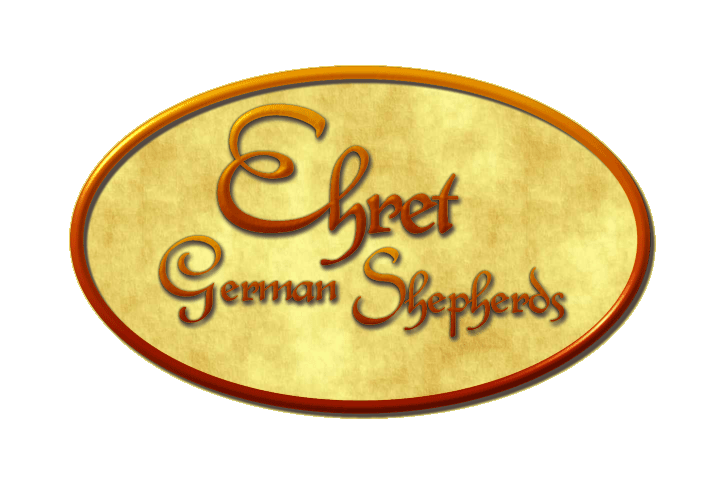
Canine Genetics
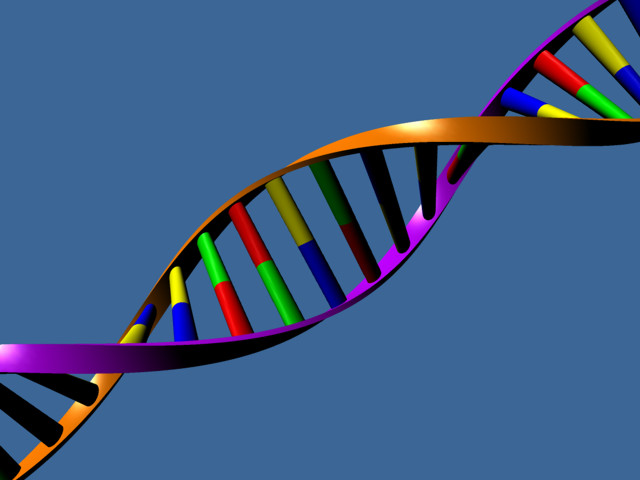



|
Origins from a Genetic Perspective
Until recent discoveries in molecular genetics, it has often been the belief that the domestic dog was descended from the wolf, because of a long prehistory where domestic dogs and the gray wolf were not all that different in outward physical characteristics. Studies have indicated that dogs are the oldest domesticated species, and likely originated even well before their first appearance in the archeological record 15,000 years ago where, the initial change to the diagnostic phenotype of domestic dogs was perhaps due in part to selection pressures associated with the transition from hunter gatherer to more sedentary lifestyles.
|

|
Dogs & Selective Breeding
A portion of a lecture at the Howard Hughes Medical Institute 2005 Holiday Lectures
No rights or restrictions, streaming media, ~14.5min., ~25MB
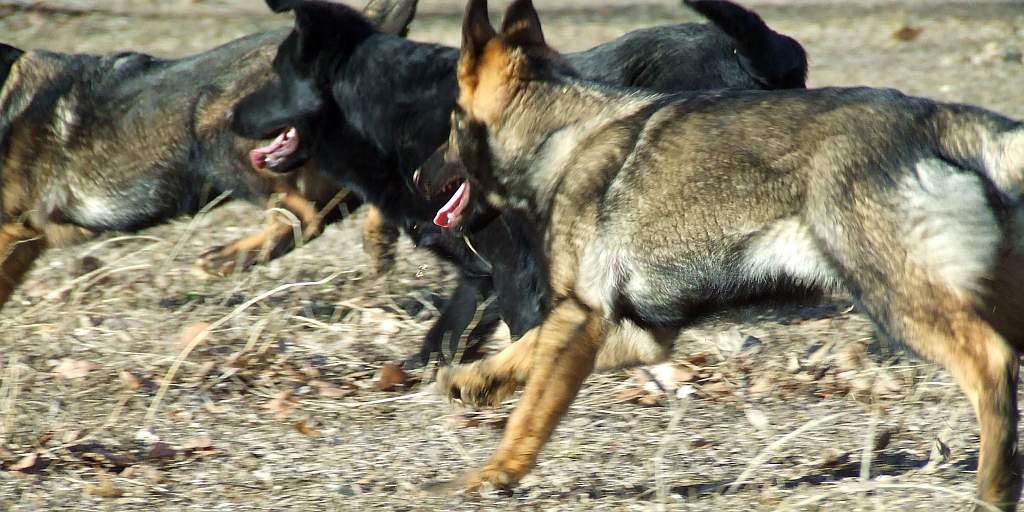

This table is designed to illustrate the relative probability of color pattern in a litter when the two genotypes are mated. The offspring genotype is in text, phenotype is color-highlited. White text signifies homogenous (same) genes. Bracketed genotypes indicate a surfaced recessive phenotype in the offspring, different from those exhibited by it's parents.
Genotype: Phenotype and its recessive gene
White Lettering: Homogenous Traits (duplicate)
Black Lettering: Heterogenous Traits (differing)
[Brackets]: Progeny's phenotype is different from either parent's phenotype
Understanding Linebreeding & Outcrossing
Linebreeding
Linebreeding can increase the possibility of expression of undesireable, as well as, desirable genetic characteristics. This is why it is very important to know and understand the strengths and weaknesses of dogs before making a lot of breeding decisions. Linebreeding/inbreeding "locks in" characteristics by limiting the possible genes that the pups carry. With inbreeding & close line breeding you normally can not expect to produce anything better than what you start with (the parents).
You are breeding a much smaller subset of the GSD gene pool. And you end up with dogs that have a greater chance of being homozygous for many traits (carry two copies of the same gene, rather than one each of the range of possiblities for THAT gene).
Equally as important if you are line breeding, you also increase the chances that problem genes will be expressed in the puppies. In long lines of strictly line bred animals there is an increase in the chances for genes to mutate and be expressed.
Often in lines that are extensively linebred (nine or more generations), there tends to become a decrease in the quality of the line, due to the lack of genetic material to draw from. This is known as inbreeding depression, and can result in decreased fertility. This is part of the reason why very close breedings are discouraged (brother to sister, father to daughter, mother to son). These close breedings can and have been used to strengthen a trait, but they are almost always followed with an outcross.
Line breeding is also useful in the bringing out of recessive genes. It increases the chances that you will have both genes be recessive in an offspring if the line is bred closely. Close line breeding can become a crap shoot because you may end up with something you don't want and then have to go more aggressively for outcrossing to get rid of the trait.
Outcrossing
With outcrossing you have the chance to produce something better than the parents. The phenomenon of "Hybrid vigor" occurs when the puppies are better than the average of the parents.
So, when you outcross, you are expanding the gene pool again. There are two main results:
ONE: You cross two lines that have been bred for most of the same traits and you get very similar traits, but possibly improve on a trait your line is weak on. For example, if your line has floppy ears and you outcross to a very similar line, but one with good ears, you will keep the same "type", but have some pups with better ears than your line has been producing.
TWO: If you breed to a line that has been breeding for a different set of traits than your line, you will get a huge variation in the trait that the pups express. You are, in essence, doubling the possibilities for the traits of the pups. You will probably end up with some great dogs and some horrible dogs, but neither type will tend to be "prepotent", which means "tends to reproduce like itself", because they will tend to be heterozygous, having two different genes, rather than two copies of the SAME possible gene, or homozygous.
If you want to suppress the expression of some unwanted gene, you outcross. If you want to eliminate a trait, inbreed to bring it to the surface and then remove the affected dogs from the gene pool. The outcrossing works short-term but allows the recessives to spread thru the genepool without anyone knowing who carries it. This makes it more likely that it will become a widespread problem in the breed. With the inbreeding, you see these undesirable traits within a few generations and can quickly weed them out. However, when you go back to an outside line, you run the risk of bringing these recessives back into your line.
If you only outcross after outcross etc., and you only use excellent examples for breeding, your going to be able to find some excellent puppies in these litters. The problem is that the line loses it's seperate identity quickly and hybrid vigor decreases with each outcross.
Linebreeding & Outcrossing; in respect to both
Linebreeding is what provides for the outcrossing that equals hybrid vigor.
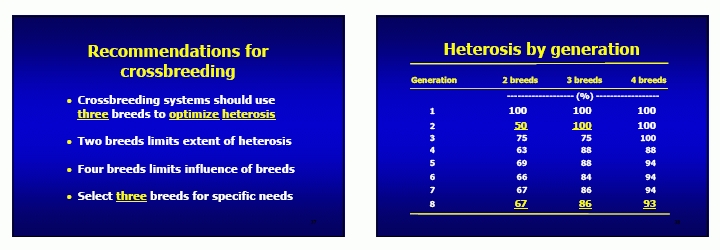
Line Breeding and outcrossing go hand-in-hand. One's not much good without the other. Too much emphasis in either direction will produce poor results.
With inbreeding or with outcrossing you can surface the undesireable recessive traits. But unless both parents carry the recessive, it may not reveal in the offspring, and some (about 25%) of the pups produced by carriers bred to non-carriers will also be carriers.
One way to test an animal for a recessive is to breed it to a known carrier and see if any of the puppies produced have the characteristic. The test breeding can be either an outcross or inbreeding, it's irrelevant.
Taken from the Dr. Denny Article on the "Principles of Genetics" part 1
"Hybrid vigor has occurred when the performance of the offspring is different from that of the average of their parents. The actual mechanism of hybrid vigor is not well understood, however, matings can be made to increase the beneficial effects of hybrid vigor. Mating of animals which are not alike in their pedigree or that are not related are those which will generally exhibit higher levels of hybrid vigor. Closely related animals do not exhibit high levels of heterosis.
Crossbreeding in plants and animals is done to take advantage of both hybrid vigor and complimentarity. Complimentarity is the term used to describe the "combining" of desirable traits from two breeds or lines that are not related. Hybrid vigor is also maximized when animals are mated that have little or no genetic history in common."
The best way to maximize Hybrid Vigor is to cross two separate, unrelated linebred lines. Breeders would benefit to keep their lines as seperate as possible from other lines, to ensure that more lines are available for hybrid vigor.
No matter what you do you will be placing pets if you breed. No matter if you linebreed or outcross. The balance is so tricky that you generally only find 10-20% of progeny are really top quality. When you add the problem of restricting your selection to fewer dogs, you will make compromises to stay with in the line. This is how problems tend to creep in. If you are looking at the ability to make the selection from a wider variety of animals and select the best from that pool you will see improvement.
In Summary
Line breeding has been a major problem driving the decline of many breeds. That does not mean that outcrossing alone becomes a sound breeding theory! It is not a question of line breeding or outcrossing. It' a question of how to obtain predictability, by taking advantage of both. Whether you are trying to get rid of a genetic disorder, or you are just trying to put some good litters on the ground, no matter the goal, a breeder won't make any progress without taking advantage of predictability.
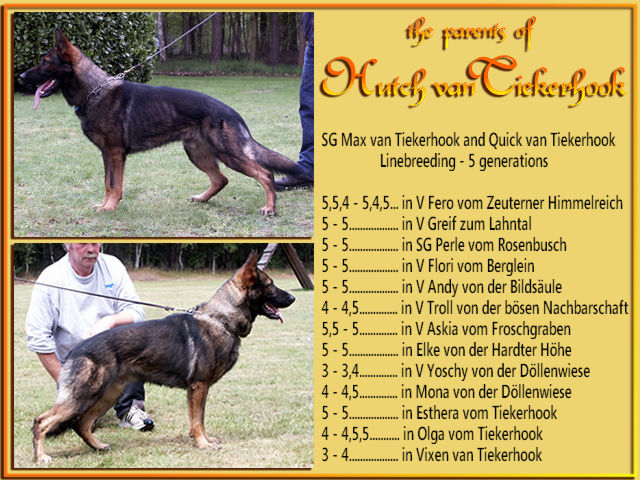
If you have any questions about our pups
or
would just like to chat, feel free to email us at:

Thanks for visiting Ehret German Shepherds!
